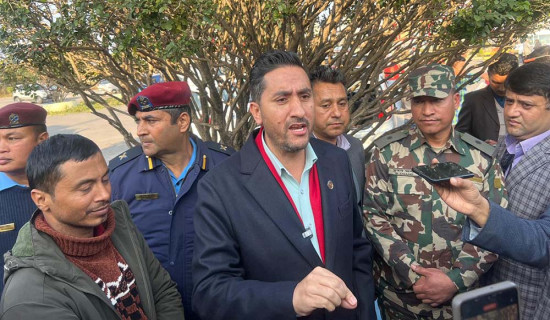- Saturday, 3 January 2026
Provincial Budgets
Physical Infrastructure In Focus
Provincial governments have recently made their respective budget estimates public for the upcoming fiscal year 2023-24. In line with the constitutional provision, they are required to unveil their annual financial plan on 1st of Asar in the Nepali calendar. However, the Koshi Province announced its budget one day before the schedule through an ordinance. The combined budget of all seven provinces stands at Rs. 279.57 billion. Excluding budget of Karnali and Madhes, all other provincial budgets are smaller in size for the next fiscal year as compared to the current one. The existing economic crisis is the main reason for the reduction in budget.
Having its budget of Rs. 62.70 billion, Bagmati Province tops others while Sudurpaschim’s budget is the smallest in size with Rs. 29.26 billion. Madhes Province has the second largest budget in size (Rs. 44.11 billion) after Bagmati. Lumbini Province has the third biggest budget with Rs. 40.47 billion, while the budget of Koshi Province is Rs. 36.24 billion. In terms of budget size, Gandaki (Rs. 33.42 billion) and Karnali (Rs. 33.37 billion) are in the fifth and sixth positions, respectively.
Positive side
It is significant that most provinces have allocated a huge amount of their budget for building the physical infrastructure. This is really a positive side. But the utilisation of their capital budget has not remained so effective over the years because of weak implementation. Of its total budget, Bagmati Province has allocated Rs. 35.50 billion for capital expenditure. Koshi, Madhes, Lumbini, Gandaki, Karnali and Sudurpaschim provinces have set aside Rs. 18.23 billion, Rs. 26.69 billion, Rs. 23.25, Rs. 20.19 billion, 19.57 billion and Sudurpaschim Rs. 17.02 billion for capital expenditure, respectively.
The provincial budgets have accorded priority to a wide range of sectors such as productive areas, commercial uses of forest products and herbs, tourism, investment promotion in health, education, drinking water and housing sectors, social development and cultural transformation, integrated quality and sustainable development, employment creation, proper and sustainable utilisation of natural resources, entrepreneurship development, poverty reduction, and protection and promotion of sports, language, art and culture.
However, the provincial governments seem to have laid much emphasis on the agriculture sector in order to generate more incomes and jobs. Despite having huge prospects, agriculture still remains neglected. This has led to a remarkable drop in agricultural production nationwide. With an increasing trend among Nepali youth to go abroad in search of a job and better life prospects, even arable lands in many parts of the nation have been rendered barren.
An acute shortage of chemical fertilisers has been a recurring problem faced by farmers. When this vital agricultural input is not made available on time, there is naturally less production. A lack of irrigation facility is another issue taking toll on farmers every year. Because of this, many farmers across the country are bound to rely on rains for farming staple crops like paddy and maize. They fail to have good yields due to unreliable rains. With noticeable fluctuations in climatic conditions, the pattern of rainfall also appears to have changed.
As agriculture has turned out to be less productive, provinces have now come up with plans to support this important sector. Bagmati Province plans to install organic fertiliser plants with an aim of contributing to agricultural production. It has allocated Rs. 50 million for this. The provincial government has also wanted to promote seeds and saplings of indigenous varieties of food. To give due recognition to the agriculture sector, the province has planned to issue identity cards to farmers.
Besides, the province has also adopted a policy to stimulate homestays and expand tourism infrastructure, facilities and services in order to lengthen the stay of tourists. In order to revitalise the tourism industry, the provincial government is going to celebrate 2024 as Visit Bagmati Province Year. Being home to numerous world-class cultural and natural heritages, the province hosts a large number of foreign as well as domestic tourists every year.
The Koshi provincial government has also prioritised the development of physical infrastructure, agriculture, water supply and energy. It has allocated Rs. 18.23 billion for capital spending alone. The province intends to create more jobs in the agriculture sector. As renowned tourist destinations like the Khumbu Region fall in this province, the provincial government could do much in the tourism sector. Similarly, in its annual budget, the Madhes provincial government has given priority to developing infrastructure, upgrading the quality of education and health services. It has also aimed at expanding irrigation facilities, providing jobs and establishing good governance.
Ambitious target
Lumbini Province has come forward an ambitious target of generating 200,000 more jobs through the Chief Minister Economic Development Programme. It has set aside 20 million for developing small and medium-scale industries in order to create jobs. Besides, the province has schemes to promote and develop skills, capital and technology. Likewise, the Gandaki Province government has prioritised agricultural production and productivity, highlight tourism, job creation and development of sustainable physical infrastructure.
Meanwhile, the Karnali province has focused on physical infrastructure, transport and urban development. A stadium will be built in Birendranagar. This will be one of the leading infrastructure projects of the province. The province also plans to create at least 10,000 new jobs every year through its Karnali Prosperous Campaign. Sudurpaschim Province has also put much emphasis on the development of the agriculture sector. The provincial budget plans to work towards making the province self-sufficient in food production. The province it has allocated Rs. 40 million in order to provide interest-free loans to farmers.
Provinces are important components of federalism so the provincial governments need to implement their respective budgets in a more effective manner. They must also adopt austerity measures and maintain fiscal discipline in order to achieve the target of the budget.
(The author is a deputy executive editor of this daily.)

















